- Accessories
- Entertainment
- PCs & Components
- Wi-Fi & Networks
- Newsletters
- Digital Magazine – Subscribe
- Digital Magazine – Log in
- Smart Answers
- Best laptops
- Best antivirus
- Best monitors
- Laptop deals
- Desktop PC deals
When you purchase through links in our articles, we may earn a small commission. This doesn't affect our editorial independence .

Hello, Computer: Just what was that computer Star Trek’s Gene Roddenberry used?
His vision of the future inspired legions of engineers, nerds, and techies, as well as Bluetooth headsets, the iPad, Siri, and cell phones.
But what kind of techie was the late Star Trek creator Gene Roddenberry in real life? Or more specifically, what kind of computer did the man use?
These questions all bubbled up when Gene Roddenberry’s long-lost floppy disks surfaced . The disks, all artifacts in themselves, were salvaged, but information about the actual computer he used to create them has been a mystery.
Roddenberry had two of these generic-looking machines. One his estate kept after he died, while the other was sold off in an auction to benefit charity in 2010. For that, auction house Julien’s Live described it as “IBM identification number ‘GS 113302’ dual floppy disk drives with built-in monitor and separate keyboard. This early portable IBM PC retailed for nearly $3,000 in the early 1980s. The metal case has a “GR” handwritten on upper left side, indicating that this computer was owned and used by Gene Roddenberry.”
The auctioned computer appears to have been purchased by a fan, where its notoriety has secured it a spot on the Star Trek convention circuit.
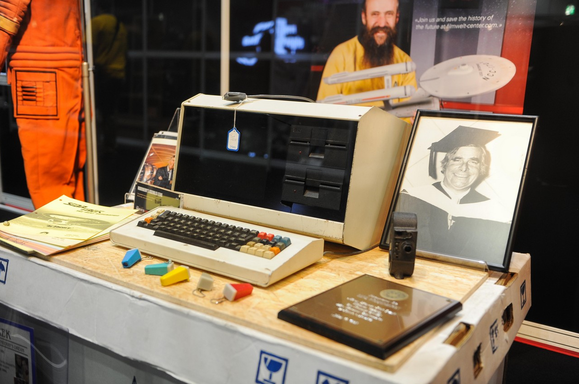
Gene Roddenberry’s computer is important enough that it even made the Star Trek convention circuit in 2014.
That’s no IBM
If you know your computers, you know that’s not an IBM PC. In fact, it’s so generic, you’d think it was one of those plastic props used in an Ikea furniture store to sell Blërg desks.
I consulted our resident vintage computing expert Benj Edwards of Vintagecomputing.com and our own “ This Old Tech ” column, and even he was stumped by the make of Roddenberry’s computer.
“That’s probably not an IBM compatible machine. It’s likely a very obscure CP/M business machine circa 1978-83,“ Edwards said after seeing pictures of it and being told of the auction house details. His educated guess was a Blackhawk Computer Systems Model III or older running on a Zilog Z-80 processor.
“It’s possible the chassis was generic and it was used by a different company to build a PC compatible machine, but judging by the keyboard, it looks like it even predates the [system Model III].”
And no, it’s not a Daystrom Institute M-5 Multitronic unit from the episode, “The Ultimate Computer.”

The Ultimate Computer in the 22nd century is still a desktop, as we can tell from this M-5 multitronic computer.
The answer is…
So what is that mysterious white box? Gene Roddenberry’s “computer” for many years was a Lexoriter, a dedicated word processor purchased in the early 1980s, according to Susan Sackett.
Sackett should know. She’s the author of several Star Trek books and worked as Roddenberry’s executive assistant from 1974 until his death in 1991.
”[The computer] didn’t do anything else—it was used strictly for writing and saving work on disks,” Sackett told PCWorld. “Later, we added an external modem so we could dial up and chat with other people, but I don’t remember much about that.”
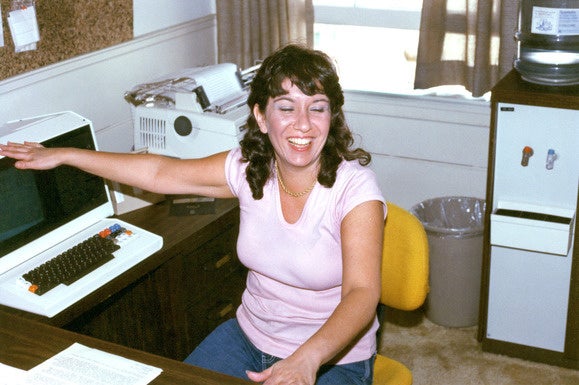
Gene Roddenberry’s long-time executive assistant Susan Sackett has a good laugh in front of one of the Lexoriter computers the Star Trek creator used.
Sackett said the pair cost about $6,000 to $7,000 and one sat on her desk with a daisywheel printer (later upgraded to a dot-matrix) while the other sat on Roddenberry’s. The disks would be handed back and forth via the classic Sneakernet of the early ’80s.
The machine itself, from what I can tell from a 1982 edition of Computerworld , had a Zilog Z-80 processor, two floppies, and the Luxor WP software on a ROM chip. It was touted as being able to interface with the popular electric typewriters of the period. Its maker, Luxor Corp., appears defunct, but the similarities with the chassis used for the CP/M-based Blackhawk Computer System that Edwards thought it was makes me wonder whether Luxor didn’t just source its chassis from Blackhawk.
One thing Sackett is certain of, though: how much RAM the computers had, because Roddenberry would brag about the whopping 64K.
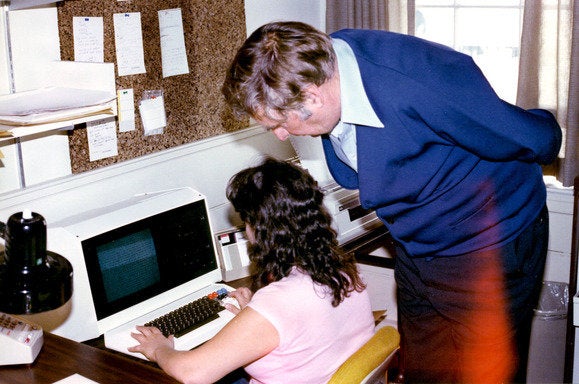
Gene Roddenberry and Susan Sackett in front of a Lexoriter “computer.” If you look close enough you can see the printer to the right of Sackett and the traditional box of 5.25-inch floppy disks.
For the most part, Roddenberry’s “computer” was mostly a glorified typewriter, but he put it to good use filling those 200 missing disks .
“Gene constantly upgraded his devices. He used them mainly for writing and rewriting his Star Trek II novel, which was never published, as well as the script, which was never filmed, and for his speeches and general rewrites of all these,” Sackett said. She also ventured a guess as to what is on those disks.
“Sorry to disappoint, but there are no long-lost Star Trek episodes on the disks! I can’t recall specifics, but it would be mostly correspondence, speeches, and script ideas for the next, at that time, movie.”
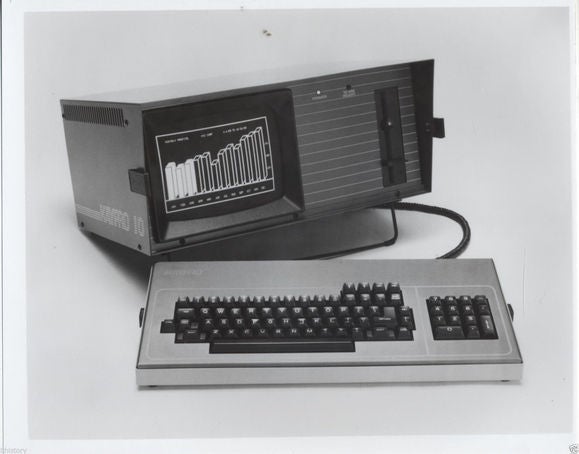
Star Trek creator Gene Roddenberry also bought a Kaypro 10 and asked “Trouble with Tribbles” writer David Gerrold to help him use it.
There was a Kaypro, too
The pair of work “computers” may not have been Roddenberry’s first personal computer, though. Science fiction author David Gerrold , who wrote the classic Trek episode “The Trouble with Tribbles” and helped developed Star Trek: The Next Generation , said he believed Roddenberry’s first personal computer was a Kaypro 10 that was bought in 1983. Knowing Gerrold to be a computer nerd, Roddenberry turned to him for help with the Kaypro 10.
Offering a little more insight on Roddenberry’s computing history, Gerrold said he didn’t recognize the pair of Lexoriters but did say Paramount provided the writing staff with “IBMs” for the work on Star Trek: The Next Generation .
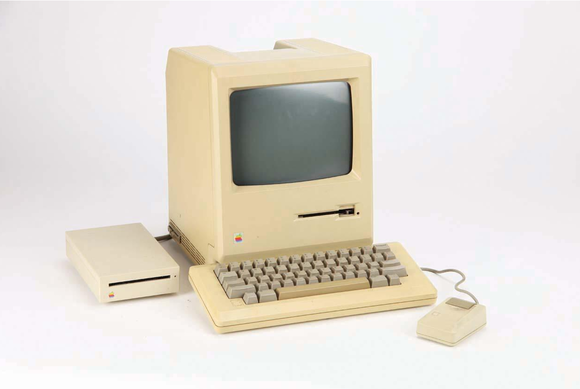
Apple gave Gene Roddenberry a Mac 128K in 1986.
But what about his Mac?
So what we know about The Great Bird of the Galaxy’s computing habits seems to point mostly to business machines. Roddenberry, however, is often associated with Apple’s Macintosh. Roddenberry did own a Mac that was given to him by Apple in 1986. That machine was auctioned off in 2009 to much fanfare and created a minor tizzy when it was wrongfully thought to be the first Mac Plus ever made. A date of 1986, however, would be well after his use of the Lexoriters and Kaypro 10.
Sackett also said she didn’t recall Roddenberry ever using the Mac much, instead continuing to buy newer PCs. Still, Mac fans will always have the one Star Trek memory over the PC and CP/M machines.
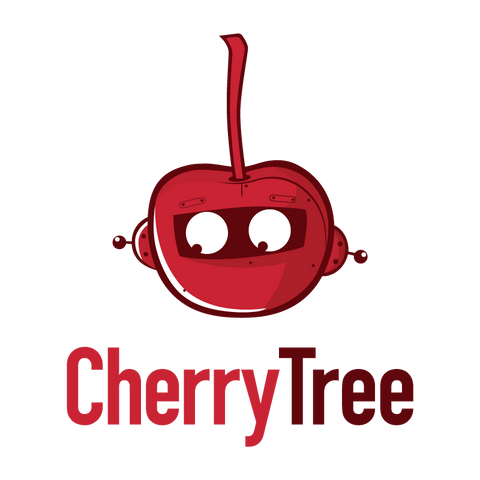
- STAR TREK™ COMPUTERS & PC CASES
- ONE-OFFS: Unique Pre-Builds
- PRE-BUILD PCs & CASES
- GEEK MACHINE PCs & CASES
- NAS DEVICES
- FIGURINES & STATUES
- CLOTHING & APPAREL
- CHERRYTREE ORIGINALS
- ACCESSORIES & REFURBISHED
- HELP CENTER
- TESTIMONIALS
- CHERRYTREE ARBORISTS
- ABOUT CHERRYTREE
- TERMS & CONDITIONS
- PRIVACY POLICY
BESPOKE CREATIONS
- STAR WARS™ COMPUTERS & ACCESSORIES
- STAR TREK: PICARD LIMITED COLLECTOR'S EDITION
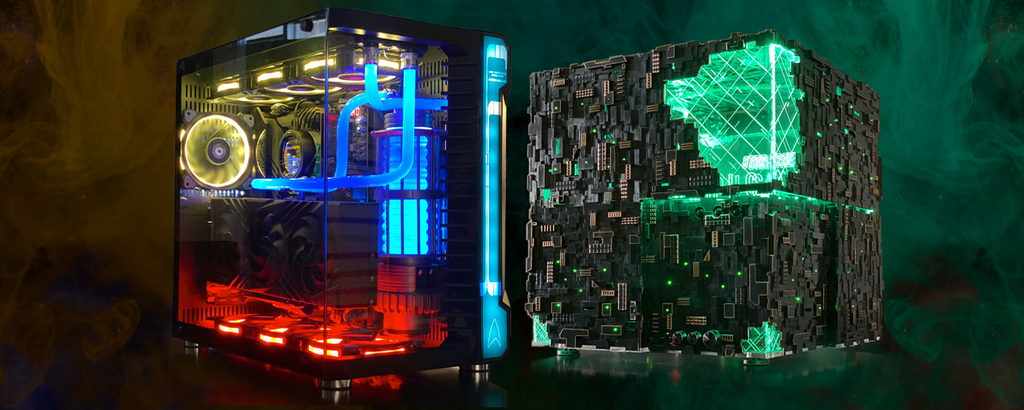
STAR TREK PCs & CASES
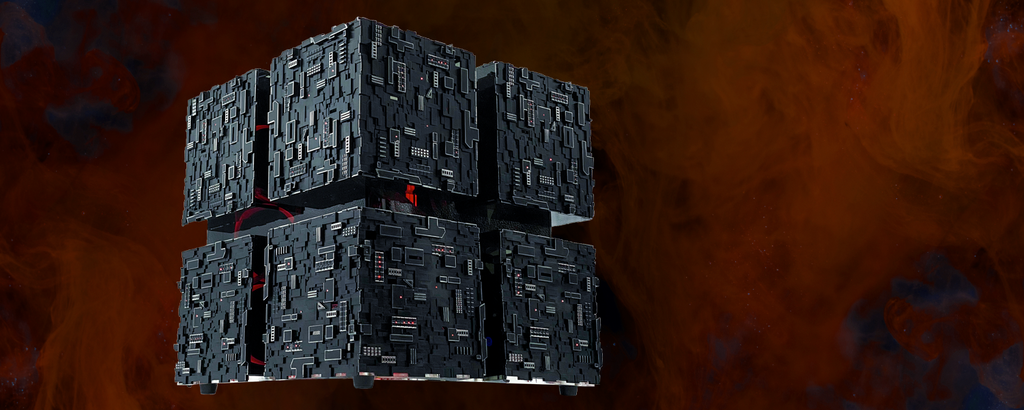
BORG FUSION CUBE PC

ONE-OFFS & PREBUILDS
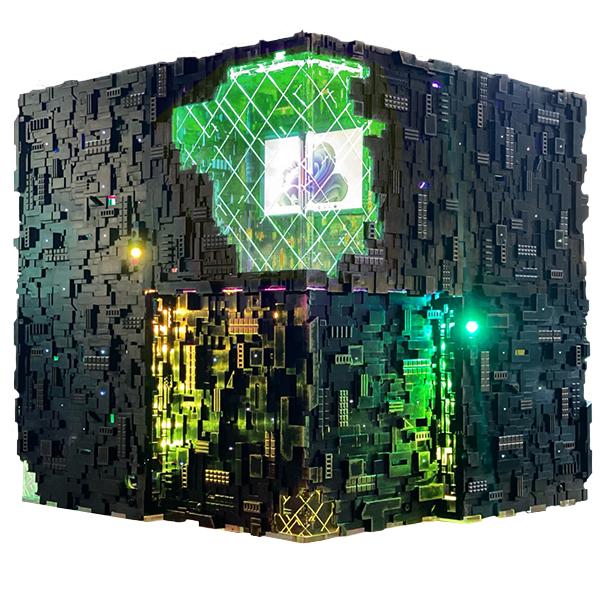
Borg Cube PCs
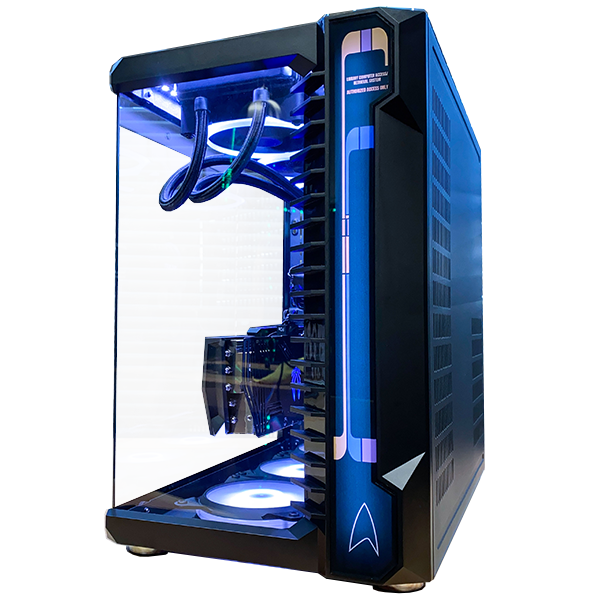
Geek Machine™ PCs
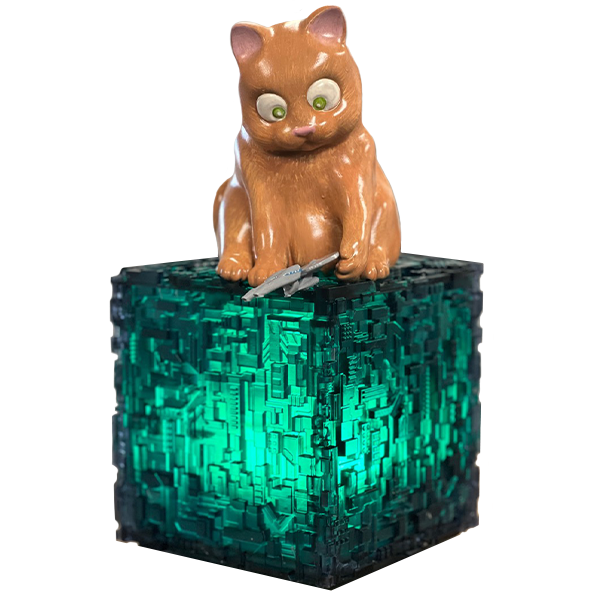
Lighting & Decor
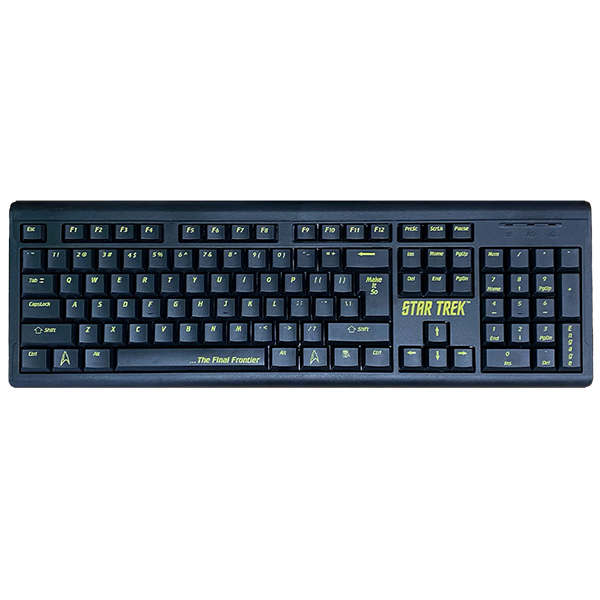
Peripherals & Accessories
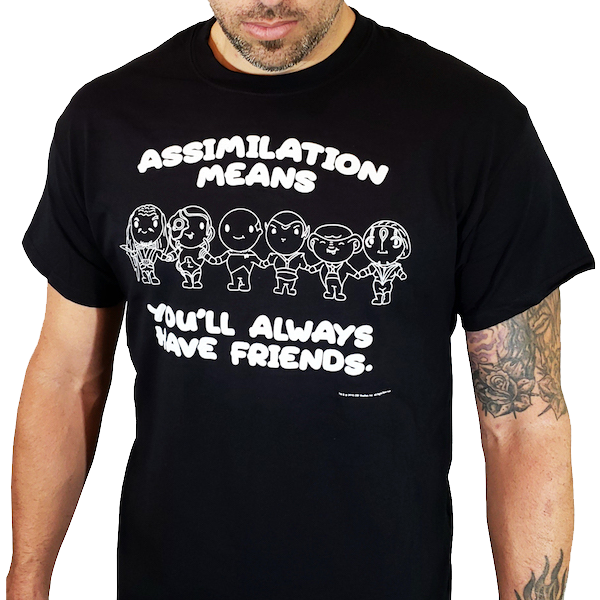
FEATURED COMPUTERS, PC CASES and ACCESSORIES
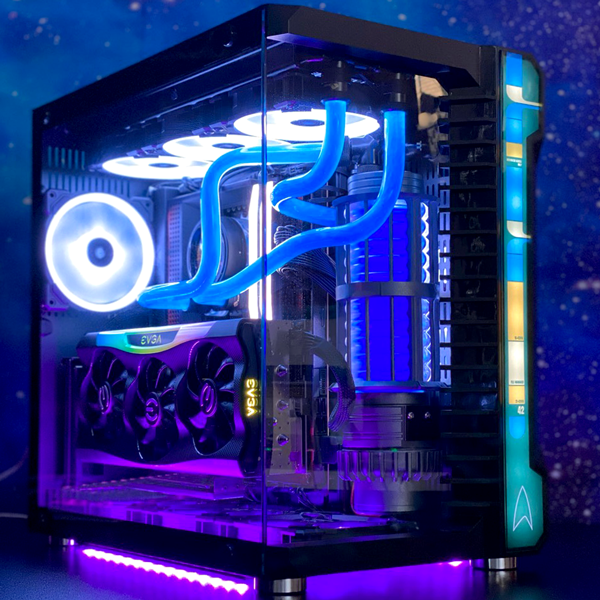
Resistance is futile...
Our Limited Collector's Edition Star Trek: Picard Borg Cube ATX PC is part-machine, part-functional statement art piece has become a popular choice on our roster for tech enthusiasts and Star Trek fans alike.
Make it your Number One
With in-house customizations, each PC becomes a truly unique masterpiece. Whether you're a Sci-Fi fan or a tech enthusiast, our PCs are sure to turn heads and provide an extraordinary computing experience.
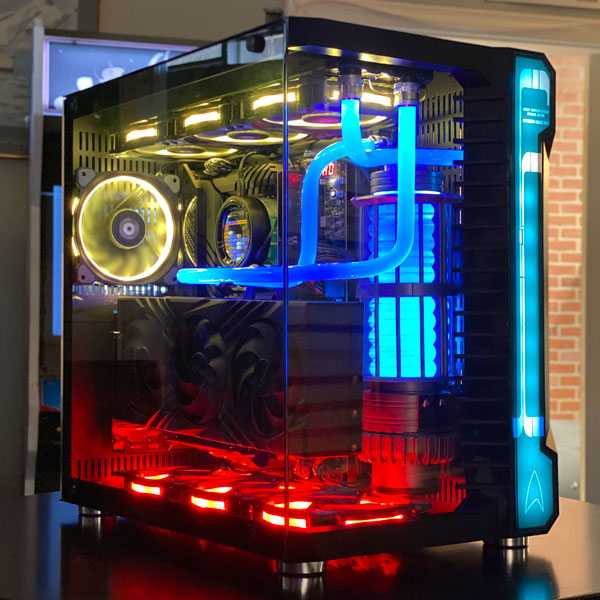
We Are CherryTree.
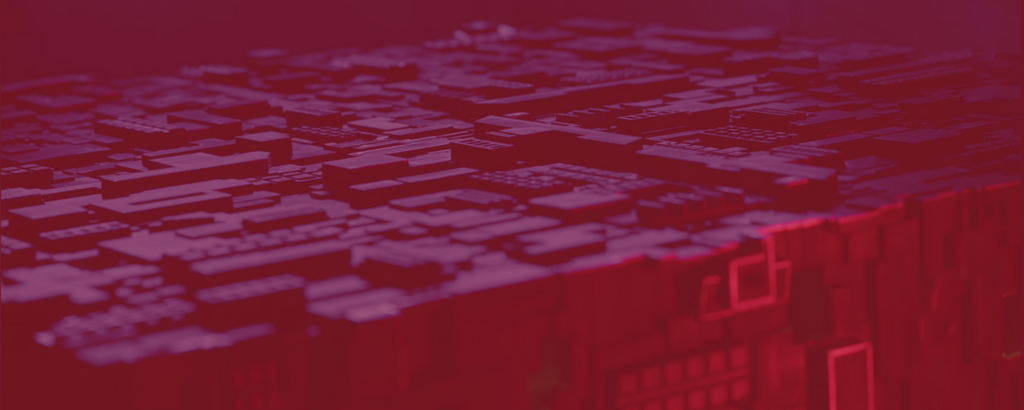
Here’s Why You’ll Never Find CherryTree Inc. PCs and Cases on Amazon
While we always appreciate customers that want to see our business grow by utlizing additional platforms, our decision to not sell on Amazon was made in the best interests of our customers, our commitment to supporting small businesses, and maintaining the quality and integrity of our products.

How It’s Made - Our Star Trek: Picard Borg Cube ATX PC

We've removed our shop from the Shop App!
A harmony of purpose and art.
We will add your distinctiveness to our own. The CherryTree hive mind wanted to create custom computers and machines you don’t need to hide under your desk. Tech that reflects things you treasure. All of us have one goal in mind, and that is to combine the beauty and awesomeness of SciFi Props and Vessels with modern technology - because we’re just a bunch of geeks who love SciFi just as much as you do. Our computers, NAS devices and PC cases are designed, manufactured and assembled by our very own team in Los Angeles, California. With the continued support of our ever-growing CherryTree family, we’re going where no small computer company has gone before - and we hope you’ll join us for the ride.

Sign up to our newsletter and we’ll keep you up to date with the latest arrivals
21430 Strathern St. Unit A, Canoga Park, CA 91304 Phone: 818 459 9555 Monday - Friday 9:00am - 5:00pm PST

Terms & Conditions
- OUR STORY ·
- SHOP ·
- SEARCH ·
- PRESS & NEWS ·
- AFFILIATES ·
- Terms of Service ·
- Refund policy


- Computers & Technology
- Computer Science

Enjoy fast, free delivery, exclusive deals, and award-winning movies & TV shows with Prime Try Prime and start saving today with fast, free delivery
Amazon Prime includes:
Fast, FREE Delivery is available to Prime members. To join, select "Try Amazon Prime and start saving today with Fast, FREE Delivery" below the Add to Cart button.
- Cardmembers earn 5% Back at Amazon.com with a Prime Credit Card.
- Unlimited Free Two-Day Delivery
- Streaming of thousands of movies and TV shows with limited ads on Prime Video.
- A Kindle book to borrow for free each month - with no due dates
- Listen to over 2 million songs and hundreds of playlists
- Unlimited photo storage with anywhere access
Important: Your credit card will NOT be charged when you start your free trial or if you cancel during the trial period. If you're happy with Amazon Prime, do nothing. At the end of the free trial, your membership will automatically upgrade to a monthly membership.
Buy new: $11.47 $11.47 FREE delivery: Thursday, May 2 on orders over $35.00 shipped by Amazon. Ships from: Amazon Sold by: Amglen LLC
Return this item for free.
Free returns are available for the shipping address you chose. You can return the item for any reason in new and unused condition: no shipping charges
- Go to your orders and start the return
- Select the return method
Buy used: $6.85

Download the free Kindle app and start reading Kindle books instantly on your smartphone, tablet, or computer - no Kindle device required .
Read instantly on your browser with Kindle for Web.
Using your mobile phone camera - scan the code below and download the Kindle app.

Image Unavailable

- To view this video download Flash Player
Follow the authors

The Computers Of Star Trek Hardcover – December 8, 1999
Purchase options and add-ons.
- Print length 192 pages
- Language English
- Publisher Basic Books
- Publication date December 8, 1999
- Dimensions 5.5 x 0.75 x 9 inches
- ISBN-10 0465012981
- ISBN-13 978-0465012985
- Lexile measure 1160L
- See all details

Popular titles by this author

Editorial Reviews
From library journal, about the author.
Robert Weinberg holds a B.S. and an M.S. in mathematics and has taught at the Illinois Institute of Technology. His fiction writing has been nominated for the Hugo, World Fantasy, and Balrog Awards. He is a two-time winner of the World Fantasy Award and his anthology Horrors: 365 Scary Stories won the 1998 Bram Stoker Award of the Horror Writer's Association. He lives in Chicago.

Product details
- Publisher : Basic Books (December 8, 1999)
- Language : English
- Hardcover : 192 pages
- ISBN-10 : 0465012981
- ISBN-13 : 978-0465012985
- Lexile measure : 1160L
- Item Weight : 12.8 ounces
- Dimensions : 5.5 x 0.75 x 9 inches
- #30,633 in Computer Science (Books)
- #229,000 in Science Fiction (Books)
About the authors
Robert weinberg.
I was born on August 29, 1946, making me one of the famous "baby boomer" generation. I attended Hillside High School in New Jersey, then got my B.S. degree in mathematics at Stevens Institute of Technology. I later obtained by M.S. in mathematics at Fairleigh Dickinson University, where I taught math for two years. I was working on my Ph.D. in Number Theory at the Illinois Institute of Technology in Chicago when I met my (future) wife Phyllis in 1972. We were married in 1973 and I left college to start my own business. I ran three very successful corporations after leaving college and did some writing on the side. When I was 40, I decided I wanted to concentrate more on writing fiction, which I had done in college but had abandoned afterwards. So I started writing novels in 1986. My first book, THE DEVIL'S AUCTION, was published in 1988 and I've written another 16 novels since then. I'm probably best known as the author of a popular trilogy I wrote for White Wolf Games entitled THE MASQUERADE OF THE RED DEATH. These three novels have been published in a number of different languages (including French, German, Spanish and Hungarian) and I've gotten well over 1,000 fan letters about them since they first appeared. My most recent book was DRAGONS, written in collaboration with terrific artist, Tom Wood, and tells the secret story of dragons that existed in the Middle Ages. I also have written 17 non-fiction books, many of them in the pop-science field with my friend, Lois H. Gresh. And, in my spare time, I've edited around 150 anthologies. I like to keep busy!
Lois H. Gresh
LOIS H. GRESH is the New York Times Bestselling Author (6 times) and USA Today Bestselling Author (thrillers) of 31 books and more than 65 short stories, as well as the editor of anthologies INNSMOUTH NIGHTMARES and DARK FUSIONS. Her work has been published in 22 languages. Her latest books are SHERLOCK HOLMES VS. CTHULHU: THE ADVENTURE OF THE INNSMOUTH NIGHTMARES (Titan Books, 2019), SHERLOCK HOLMES VS. CTHULHU: THE ADVENTURE OF THE NEURAL PSYCHOSES (Titan Books, 2018), and SHERLOCK HOLMES VS. CTHULHU: THE ADVENTURE OF THE DEADLY DIMENSIONS (Titan Books, 2017). For 5 years, Lois was a staff book reviewer at scifi.com (now SYFY.com, the Science Fiction Cable Channel), and her work has been on national/international award ballots 8 times. She is a frequent Guest of Honor Author at large genre conventions and has appeared on television series such as The History Channel’s Ancient Aliens and Batman Tech.
WEB: http://loishgresh.blogspot.com
BLOG: http://loishgresh.blogspot.com
Customer reviews
Customer Reviews, including Product Star Ratings help customers to learn more about the product and decide whether it is the right product for them.
To calculate the overall star rating and percentage breakdown by star, we don’t use a simple average. Instead, our system considers things like how recent a review is and if the reviewer bought the item on Amazon. It also analyzed reviews to verify trustworthiness.
- Sort reviews by Top reviews Most recent Top reviews
Top reviews from the United States
There was a problem filtering reviews right now. please try again later..
- Amazon Newsletter
- About Amazon
- Accessibility
- Sustainability
- Press Center
- Investor Relations
- Amazon Devices
- Amazon Science
- Sell on Amazon
- Sell apps on Amazon
- Supply to Amazon
- Protect & Build Your Brand
- Become an Affiliate
- Become a Delivery Driver
- Start a Package Delivery Business
- Advertise Your Products
- Self-Publish with Us
- Become an Amazon Hub Partner
- › See More Ways to Make Money
- Amazon Visa
- Amazon Store Card
- Amazon Secured Card
- Amazon Business Card
- Shop with Points
- Credit Card Marketplace
- Reload Your Balance
- Amazon Currency Converter
- Your Account
- Your Orders
- Shipping Rates & Policies
- Amazon Prime
- Returns & Replacements
- Manage Your Content and Devices
- Recalls and Product Safety Alerts
- Conditions of Use
- Privacy Notice
- Consumer Health Data Privacy Disclosure
- Your Ads Privacy Choices
The best Star Trek games
The best Star Trek games you can find in this universe. Set phasers to fun.
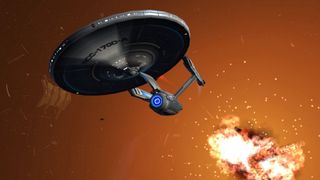
Welcome to our list of the best Star Trek games on PC. The dream of exploring space, meeting strange new life and new civilisations; cresting the Final Frontier in the next chapter of humanity’s story; kissing green aliens. All of that.
Star Trek’s relation to games has always been… shaky. Unlike Star Wars, which had Lucasarts’ hand on the tiller for at least the 1990s, it’s always been a licensed property and not often a successful one. Some studios tried to squeeze Trek into a genre it's not suited for. Others were just cash-grabs, like Star Trek: The Game Show, which relied on the comedic stylings of Q and his lovely female assistant Q to cover a truly soulless trivia contest. Still, companies keep trying, from early test adventures like The Kobayashi Alternative to the crappy game version of the JJ Abrams reboot.
But we’re not interested in those. What are the Trek games that do Gene Roddenberry’s vision proud? Here are our favourites, a collection of games which at least do enough to capture the Star Trek magic, even sometimes despite themselves.
Star Trek: Judgment Rites
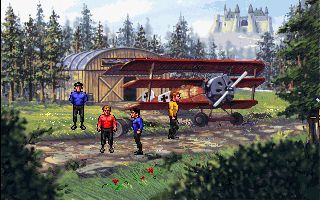
Judgement Rites isn’t the greatest game on this list, but it's arguably the best at putting you into the show. There's an authentic mix of bridge banter and combat and you're doing classic Star Trek tasks, like flying to new worlds and beaming down away teams to sort out their problems. Like its predecessor, 25th Anniversary, it followed the show’s episodic model, pitting Kirk and co against scenarios like Trelane recreating World War I on a distant planet, and a rift in time that promises the end of the Federation within eight days. Unlike 25th, there was also something of a running story involving a mysterious race watching the crew and seeing how they solved these problems, adding a little extra drama to the mix.
Neither the combat nor the adventuring is exactly top-tier, but they made a delicious pairing that was totally in keeping with The Original Series. It’s no wonder that even decades later, many still hold it up as the high point of any crew’s PC adventures.
Star Trek: Voyager, Elite Force 1 and 2
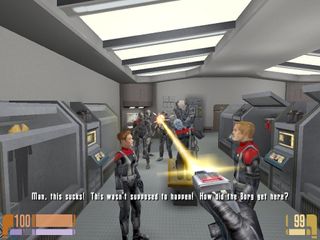
Elite Force is an rare case where it makes sense to turn Star Trek into a shooter. Voyager is lost in the depths of space, surrounded by enemies, and while risking the senior staff for every casual mission works for television, in reality it’s a pretty dreadful idea. Cue the creation of the Hazard Team, just in time for Voyager to get trapped in a spaceship graveyard full of particularly troublesome trapped alien types.
The first level, set aboard a simulated Borg ship, set a great tone, right down to the Borg not reacting to your presence until triggered. Little expense was spared. The whole crew (including, retroactively, Jeri Ryan) voice their characters, and a real effort made to make the Hazard Team feel like a unit. For a while, it was even suggested that the concept might be added to the show. It wasn’t, though something similar would show up in Enterprise in the form of the MACO assault unit. Best of all, as well as fitting the show surprisingly well, it was a very solid shooter and by far the best action game spin-off.
PC Gamer Newsletter
Sign up to get the best content of the week, and great gaming deals, as picked by the editors.
Star Trek: Starfleet Command
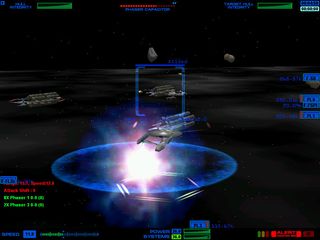
There are two basic ways to make a Star Trek game. Either you try and do everything, or you phaser-focus on one particular aspect. Starfleet Command goes all-in on space battles. Forget simply locking phasers and firing photon torpedoes, Starfleet Command is based on the table-top war-game Star Fleet Battles, and a brutal demonstration of just how hard it would be to lead a ship like the Enterprise into battle. Everything your ship has its at your disposal, from weapons to shields to special equipment, in full 3D.
It’s brutally hard, but satisfying with it. Three Starfleet Command games were released, adding proper campaigns and additional races. Later games would offer somewhat similar looking combat, though vastly stripped down to avoid the Command learning curve. Still, if you have what it takes, it’s a challenge that you won’t find elsewhere.
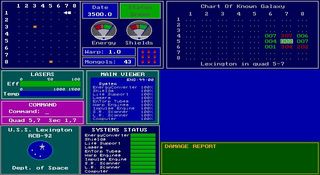
Okay, this is cheating. EGATrek isn’t an official Star Trek game. However, if you’re of a certain age, it is likely the Trek game that you remember playing first. It’s based on a game called Nettrek, originally the preserve of university servers and the like, and originally simulated the adventures of the Enterprise versus the Klingons and Romulans. After a raised eyebrow and a cough from Paramount, that became the adventures of the Lexington against an invading race called the Mongols. So, totally different!
It’s Star Trek though, right down to the ship design and use of Stardates, and your goal is to travel around and blow up all the Mongols in the system. While not much to look at now, it was definitely fun for the time—and felt a good deal more tactical than it was. It hasn’t aged well, but its place in history means it earns a place here, albeit quietly.
Star Trek: Borg
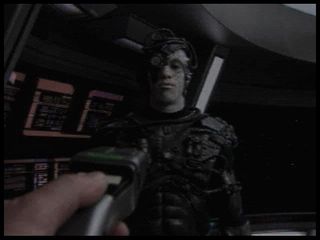
Borg is one of the most unusual Star Trek games. It’s an interactive movie, and that’s definitely a knock against it. It’s an interactive movie with style though, and some genuinely smart design. You play a cadet whose father was killed by the Borg. As you flee from another attack from the cyborg singularity, the all-powerful force of smugness Q appears and offers you a deal: go back in time with him, and see if you can save your father from his fate.
The result is genuinely surprising. Unlike the other big Star Trek interactive movie, Klingon, this one benefits from Q capering around and not taking anything even slightly seriously. You even get to kick him in the balls at one point. Star Trek games don’t get much more satisfying than that! It’s so good, the Wiki even lists ‘it is possible to punch Q in the face’ as a gameplay feature.
The true cleverness though is how it handles its time-travel premise. Screw up and Q resets time for you to try again, and quite often that’s required for a puzzle—one in particular involves getting some codes from the Borg Collective. How do you do that? Let yourself be caught, read them while you’re a Borg, and make use of them when Q rewinds time. That’s far too clever for an interactive movie, even if the rest of it—the pace, the acting, the depth—is what you’d expect.
Star Trek: Bridge Crew
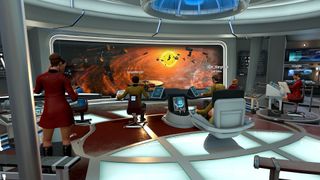
More than any other game, Bridge Crew attempted to create The Dream. It uses VR headsets to put you and your friends on the bridge of a Star Trek vessel. Largely inspired by Artemis Spaceship Bridge Simulator, it works by giving each of you a console and thus controls/information that the other players don’t have, which forces everyone to work together. The captain is in charge, but will only know the engines are about to explode if told. The captain order the phasers fired, but it’s the weapons officer who actually pulls the trigger. Success depends on how well the crew integrates and does their individual jobs.
The main problem with it is that once you’ve done this a couple of times, the lack of depth becomes very apparent. There’s not all that much to actually do, and doing it quickly becomes rote. It doesn’t help that for full effect, you need a whole cadre of friends with expensive VR equipment, which is about as likely as the Enterprise crew not using the holodecks for sex. Still, it’s the game that many fans have been waiting for, and certainly a trip while it lasts.
Star Trek: Bridge Commander
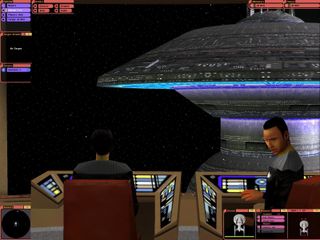
Bridge Commander is the best of the ‘command chair’ games. It is less brutal than Starfleet Command, but has more depth than the relatively simple shooter action of the adventure games or the Starfleet Academy game, which almost made the list.
The big clever feature is that you don’t control the ship so much as give orders to your individual crew members, making you feel more like a captain than a glorified pilot. You can jump in if necessary, but you’re mostly intended to sit back and trust your navigator to fly and your weapons officer to handle the combat. On top of that, it’s not just a series of quick battles; there is a full narrative campaign to work through. It is even possible to play with voice control, though not advised. When it works, it offers the full Captain experience. Far more often though, you just get blown up while swearing loudly.
Star Trek The Next Generation: A Final Unity

A Final Unity is a fondly remembered game, though honestly one that’s better fondly remembered than replayed. Creators Spectrum Holobyte clearly set out to make the greatest Star Trek game ever. The game modelled space combat, away team adventure, diplomacy, freeform exploration of the galaxy, and its cleverer features let you you call the entire TNG crew for advice and handpick away teams. In practice, the developers bit off rather more than they could chew, and in trying to replicate TNG’s more serious tone, most of the adventure is honestly sluggish, humourless and slow.
So why’s it here? Primarily because in the moments that it does work, it really captures the TNG spirit, and aesthetically and in terms of story, it’s bang on. It’s just hard not to notice how, for instance, the backgrounds get cheaper and cheaper as the story goes on, or how much of the adventure consists of interminable conversations. Still, it’s easily the best of the TNG-era games, as much as that counts when the competition is the likes of super-primitive shooter Star Trek: Generations or Insurrection tie-in The Hidden Evil. At worst, it’s a game to be admired for what it tried, even if it wasn’t all it could have been.
Star Trek: Birth of the Federation
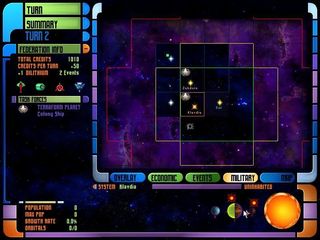
That’s right, it’s the almost inevitable Master of Orion game in the Star Trek universe, and honestly I'm being a little generous including it here. Played casually, it’s absolutely fine—a fun game of expansion and discovery and scooping up minor races to be part of your growing empire. Over time though the length of turns renders it almost unplayable. Its main hook was definitely the familiar races, and being able to play with the likes of Klingons instead of just some random warlike species. The effectiveness of this shouldn’t be underestimated, and it’s easily one of the better attempts to paste the Trek universe over an existing game. If not for that though, it’s a pale shadow of not just later games like GalCiv, but prior strategy games from its own developer Microprose.
Star Trek: Online
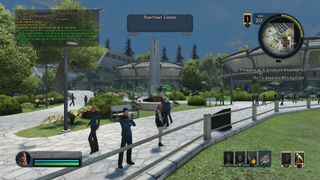
The first time I fired up Star Trek Online, I finished the tutorial, got the freedom of the universe, and immediately flew my ship to Deep Space Nine to see what, if anything, the team had done there. I was expecting to be told to come back in an expansion or two, or maybe to see the 3D model. Instead, I arrived, and was able to beam across and run around the set of the best Star Trek show of all time in pretty much all of its glory.
At its best, Star Trek Online is those moments. It continues stories from the TV shows, and even brings actors back to voice their characters. The game mixes space combot with away team action and gives you plenty of freedom to explore and chart your own path through the game. Unfortunately, since going free-to-play, much of the game pivoted around less enjoyable stuff—grinding, the push for new ships, and levelling up. Between those bits there’s still much to enjoy, including building up your crew and engaging in fun action against other players. It’s worth at least trying out, and playing for a while to enjoy the atmosphere and the satisfaction of commanding a ship in MMO space.
World of Warcraft boss says Microsoft is happy to 'let Blizzard be Blizzard,' but I'm not sure that's entirely true
A site literally called 'Spy.pet' claims to have scraped billions of public Discord messages and wants to sell them
RDNA 3+ edges closer as AMD hints at refreshed GPU architecture in its Linux firmware
Most Popular
- 2 Best ultrawide monitor for gaming in 2024: the expansive panels I recommend for PC gamers
- 3 Best wireless gaming keyboard in 2024
- 4 Best gaming laptops in 2024: I've had my pick of portable powerhouses and these are the best
- 5 Best gaming chairs in 2024: the seats I'd suggest for any gamer
- 2 Eiyuden Chronicle: Hundred Heroes review
- 3 Tales of Kenzera: Zau review
- 4 Cherry Xtrfy K5V2 review
- 5 Teamgroup Z540 2TB NVMe SSD review

Computer core
- View history
The USS Enterprise computer core, late 2260s
The computer core or memory core was the location of a starship 's or space station 's central computer .
The computer core housed primary processing equipment including the computer core processors . 23rd century Starfleet ships had duotronic systems, while 24th century ships had isolinear cores. The computer cores communicated with each other and ship's systems via an optical data network (ODN).
According to Commander Charles Tucker III , the computer core of Enterprise NX-01 was three decks high and was, as of 2152 , the most powerful computer ever created. ( ENT : " Dead Stop ")

The location of the computer cores aboard the Enterprise -B
In 2293 , the location of the computer cores aboard the Excelsior -class USS Enterprise -B were labeled in a MSD . Two of these cores were located in the primary hull and a third was located in the secondary hull . ( Star Trek Generations )
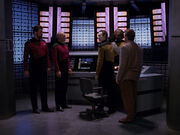
A Galaxy -class computer access room and core, c. 2360s
The Galaxy - and Excelsior -classes of Federation starships carried three computer cores, while ships of the Intrepid - and Sovereign -classes contained two. These multiple cores provided redundancy in case one of the cores was damaged or destroyed.
In 2367 , Lieutenant Reginald Barclay created a neural scan interface that communicated his thoughts directly to the USS Enterprise -D 's central processing unit . This meant much of his higher brain functions and memory were transferred to the starboard computer core while his body remained in the holodeck . His primary cerebral functions were operating almost entirely from within the computer, and had expanded to such a degree that he determined it would be impossible to return to the confines of his human brain without resulting in his death . ( TNG : " The Nth Degree ")
The computer core could be accessed by the computer access room . Linear memory crystals were part of computer cores. In 2366 , the computer core of the Enterprise -D appeared to have been tampered with, yet there was no sign of a breach of security . It was later discovered to be the result of a nanite infestation. ( TNG : " Evolution ")
In 1996 , Henry Starling managed to download almost twenty percent of the USS Voyager 's computer core to his personal computer by using the ship's transporter beam as a downlink . ( VOY : " Future's End ", " Future's End, Part II ")
After beaming aboard the IKS Drovana to obtain the detonation codes for a Klingon minefield in 2372 , Worf and Kurn told an officer they were running a diagnostic on the starship's computer core. ( DS9 : " Sons of Mogh ")
In 2373 , Worf told Nog to load the files of a phaser relay operating system into the USS Defiant 's computer core. ( DS9 : " Soldiers of the Empire ")
That same year, Commander Chakotay noted that a piece of organic technology aboard a Species 8472 bio-ship looked like a binary matrix but it was laced with neuropeptides , which he further speculated to be its version of a computer core. ( VOY : " Scorpion ")
In order to take Deep Space 9 's computer systems offline and prevent the Dominion from destroying a minefield covering the Bajoran wormhole , Kira Nerys and Rom considered planting a bomb in the station's computer core. They later attempted to sabotage it by more standard means. ( DS9 : " Sacrifice of Angels ")

The refitted computer core aboard the USS Discovery
Programmable matter was installed into the USS Discovery 's computer core and control surfaces as part of her refit in the 32nd century ( DIS : " Scavengers "). ( DIS : " That Hope Is You, Part 2 ")
Star Trek: The Next Generation (1987–1994)
Majel barrett: enterprise computer, lwaxana troi, narrator, enterprise computer voice, computer.
- Photos (34)
Photos

Quotes
Lieutenant Worf : Mrs. Troi... I must protest your unauthorized presence on the bridge!
Lwaxana Troi : [pointing to tactical console] What does that little one do Mr. Woof?
Lieutenant Worf : Please Madame! That's is a torpedo launch initiator and it's - it is Worf madame, not Woof.
Release Dates | Official Sites | Company Credits | Filming & Production | Technical Specs
- Full Cast and Crew
- Release Dates
- Official Sites
- Company Credits
- Filming & Production
- Technical Specs
- Plot Summary
- Plot Keywords
- Parents Guide
Did You Know?
- Crazy Credits
- Alternate Versions
- Connections
- Soundtracks
Photo & Video
- Photo Gallery
- Trailers and Videos
- User Reviews
- User Ratings
- External Reviews
- Metacritic Reviews
- Episode List
Related Items
- External Sites
Related lists from IMDb users

Recently Viewed

IMAGES
VIDEO
COMMENTS
The Ultimate Computer: Directed by John Meredyth Lucas. With William Shatner, Leonard Nimoy, DeForest Kelley, William Marshall. Kirk and a sub-skeleton crew are ordered to test out an advanced artificially intelligent control system - the M-5 Multitronic system, which could potentially render them all redundant.
A computer was, according to Data, "an electronic or mechanical apparatus capable of carrying out repetitious or complex mathematical operations at high speed. Computers are used to control, process, perform, or store information." (TNG: "The Big Goodbye") By the 23rd century, Starfleet qualified Spock as an A-7 computer expert, and, along with Captain James T. Kirk, he was one of the most ...
The Computers of Star Trek. Summary [] Blurb From the beginning in 1967, when the starship Enterprise first set off to seek out new civilizations, we have marveled at the wonders of the computers in Star Trek.Inspired by the computers described in the popular TV series and its offshoots, Lois Gresh and Robert Weinberg discuss contemporary ideas about computers and their role in our lives.
An LCARS panel from Star Trek: Voyager, similar to one shown in the third-season episode "Displaced".The colors of the backlit artwork have faded over time; the panel looks more yellow and blue in the episode. In the Star Trek fictional universe, LCARS (/ ˈ ɛ l k ɑːr z /; an acronym for Library Computer Access/Retrieval System) is a computer operating system.
This unit must survive.M-5 The M-5 multitronic unit, or the M-5 computer, was an advanced multitronic computer system and prototype created by Doctor Richard Daystrom during the mid-23rd century. It utilized very sophisticated technology, probably similar to the Human neural network, and much more sophisticated than the duotronic computer commonly in use at the time. According to Dr. Daystrom ...
"The Ultimate Computer" is the twenty-fourth episode of the second season of the American science fiction television series Star Trek. Written by D.C. Fontana (based on a story by Laurence N. Wolfe) and directed by John Meredyth Lucas, it was first broadcast on March 8, 1968.. In the episode, the crew of the Enterprise race to disable a rogue computer in total control of the ship.
The auctioned computer appears to have been purchased by a fan, where its notoriety has secured it a spot on the Star Trek convention circuit.. Daniel Lewis. Gene Roddenberry's computer is ...
The episode was part of the second season of Trek and aired in the United States on March 8, 1968. "The Ultimate Computer" featured William Shatner (Kirk), Leonard Nimoy (Spock), DeForest ...
CherryTree specializes in custom-made hardware and software for home, business, and studio. Makers of the the only officially licensed Star Trek™ Borg Cube PC and Star Trek computers, tower cases, and NAS devices. Based in Los Angeles, California in the United States.
On Deep Space Nine, the station's perpetual need for repair is the bane of Chief O'Brien's existence.But in "Civil Defense," it becomes the entire crew's problem when he and Jake set off an old Cardassian alarm while deleting some files.The computer thinks a Bajoran miners' strike is taking place, and seals the crew off into various real-life escape room scenarios, with a pre ...
Season 2 Episode 24Production No. #053Episode: "The Ultimate Computer"Doctor Richard Daystrom, the computer specialist responsible for the basic design of al...
The Library Computer Access and Retrieval System (LCARS for short) was the main computer system employed by the United Federation of Planets by the mid-24th century. It was used aboard all Starfleet vessels, starbases, and space stations. (Star Trek: The Next Generation; Star Trek: Deep Space Nine; Star Trek: Voyager; Star Trek: Picard) LCARS was accessible virtually anywhere in a facility or ...
Star Trek: Created by Gene Roddenberry. With Leonard Nimoy, William Shatner, DeForest Kelley, Nichelle Nichols. In the 23rd Century, Captain James T. Kirk and the crew of the U.S.S. Enterprise explore the galaxy and defend the United Federation of Planets.
"Star Trek" The Ultimate Computer (TV Episode 1968) cast and crew credits, including actors, actresses, directors, writers and more. Menu. ... My Favorite Star Trek The Original Series Episodes!! a list of 42 titles created 01 Feb 2020 Star Trek a list of 21 titles ...
Star Trek is an American science fiction media franchise created by Gene Roddenberry, ... Prodigy is the first Star Trek series to specifically target younger audiences, and is the franchise's first fully computer animated series. Star Trek saturation would hit a new peak in 2022, with five Star Trek series airing in the same year.
Some of the computer technology shown in the four Star Trek series is already out of date, especially in the original series where those computers resemble large mainframe 1st or second generation computers using vacuum tubes or discrete transistors, and this is a reflection of when the various series were made, from the 1960's to the present.
This is a supercut of all the voice interactions between characters and a computer that occur in Star Trek: The Next Generation, Season 4. Each clip is cut t...
Enterprise is used to test the new M-5 computer. The USS Enterprise is summoned to a space station by Commodore Enwright without explanation. Commodore Bob Wesley, commanding the USS Lexington, explains in the Enterprise's transporter room that the Enterprise will be a test vessel for a revolutionary tactical computer called the M-5 multitronic unit, designed by the brilliant Dr. Richard ...
Star Trek: Voyager, Elite Force 1 and 2. Elite Force is an rare case where it makes sense to turn Star Trek into a shooter. Voyager is lost in the depths of space, surrounded by enemies, and while ...
Going beyond current scholarship on robots and AI to focus on voice-interactive computers, breaks new ground in questions surrounding media, technology, and gender. It makes important contributions to conversations around the gender gap and the increasing acceptance of transgender people. 978-1-4529-6412-6.
Dr. McCoy : To James T. Kirk, Captain of the Enterprise. Captain James T. Kirk : [about Dr. Daystrom] At the age of twenty-four, he made the duotronic breakthrough that won him the Nobel and Zee-Magnees prizes. Dr. McCoy : In his early twenties, Jim. That's over a quarter of a century ago.
The location of the computer cores aboard the Enterprise-B. In 2293, the location of the computer cores aboard the Excelsior-class USS Enterprise-B were labeled in a MSD. Two of these cores were located in the primary hull and a third was located in the secondary hull. (Star Trek Generations) A Galaxy-class computer access room and core, c. 2360s
Star Trek: The Next Generation (TV Series 1987-1994) Majel Barrett as Enterprise Computer, Lwaxana Troi, Narrator, Enterprise Computer Voice, Computer. Menu. Movies. Release Calendar Top 250 Movies Most Popular Movies Browse Movies by Genre Top Box Office Showtimes & Tickets Movie News India Movie Spotlight.